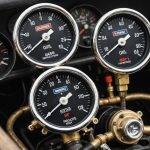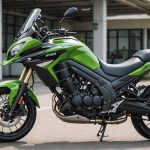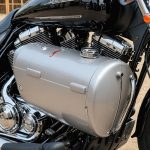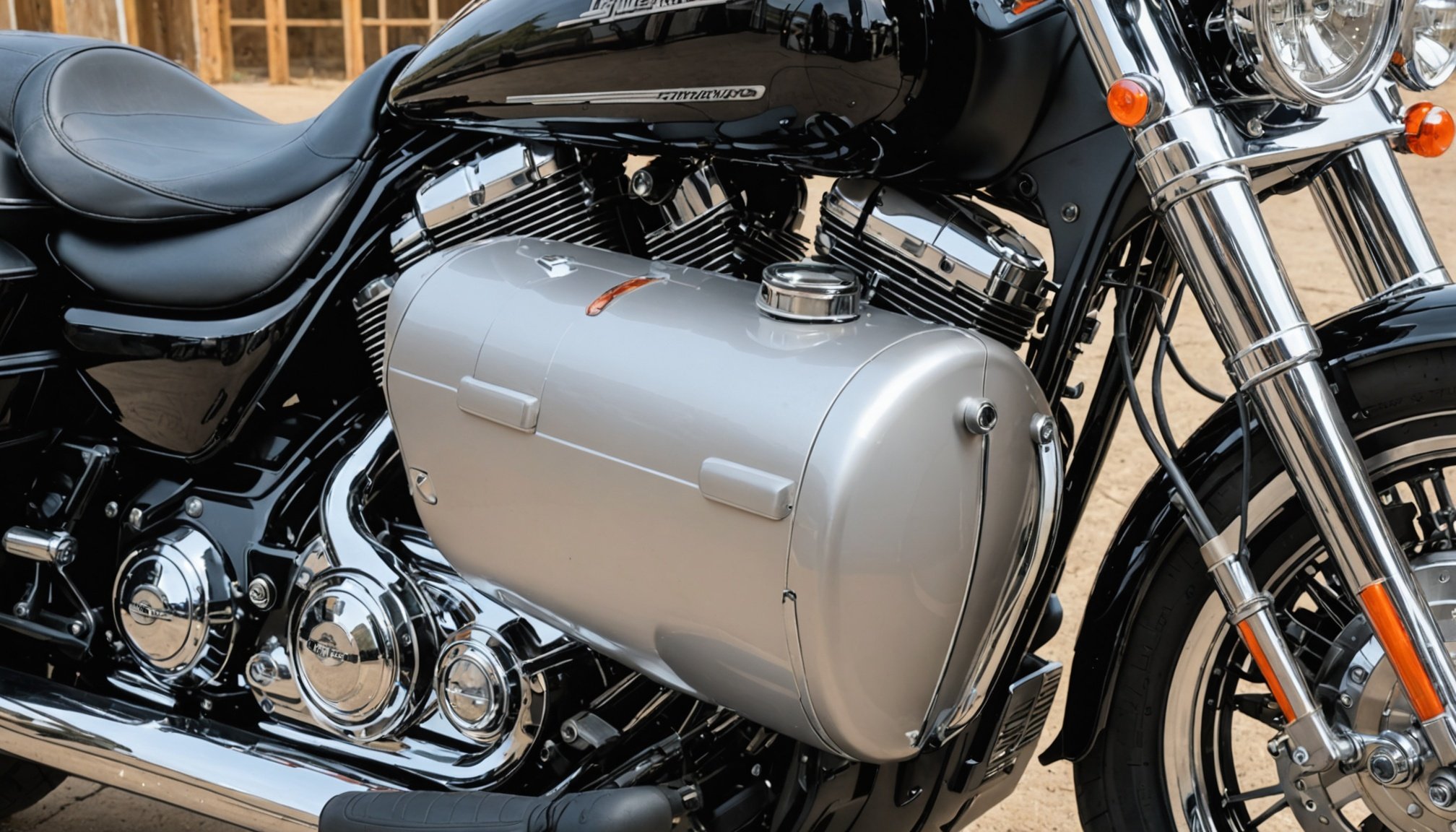Ultimate DIY Tutorial: Installing a New Fuel Tank on Your Harley-Davidson Road King Classic
Preparing for the Installation
Before you embark on the journey of installing a new fuel tank on your Harley-Davidson Road King Classic, it’s crucial to prepare thoroughly. Here are some steps and considerations to keep in mind:
Gather Necessary Tools and Parts
To ensure a smooth installation, you’ll need the following tools and parts:
Also to discover : Boost your kawasaki versys 650”s mileage: key maintenance hacks for optimal performance
- A new fuel tank compatible with your Road King Classic
- Adapter brackets (if your new tank is not a direct fit)
- 3/8-16 fasteners
- Quarter inch nut driver
- Half inch drive socket
- Center punch and drill bits
- Rubber grommets and washers from your stock tank
- New fuel line and fittings (if necessary)
Here’s a detailed list of what you might need:
- New fuel tank
- Adapter brackets
- 3/8-16 fasteners
- Quarter inch nut driver
- Half inch drive socket
- Center punch
- Drill bits (starting with a smaller size)
- Rubber grommets
- Washers
- New fuel line and fittings (if necessary)
- Vacuum line (if your fuel valve is vacuum-type)
- Vented gas cap (if switching from a non-vented cap)
Understand Your Bike’s Specifications
The Road King Classic, like other Harley-Davidson models, has specific requirements for fuel tanks. For instance, the standard fuel tank on a Road King is 6 gallons, but you might be looking to install a custom or aftermarket tank. Make sure the new tank is compatible with your bike’s frame and engine setup.
Additional reading : Elevate your suzuki sv1000: an easy step-by-step guide to headlight bulb replacement using minimal tools!
Removing the Old Fuel Tank
Removing the old fuel tank is the first major step in the installation process. Here’s how you can do it:
Step 1: Remove the Gas Line from the Fuel Valve
Start by disconnecting the gas line from the fuel valve. Use a quarter inch nut driver to loosen the hose clamp, and then pull the line off using pliers to avoid spilling fuel. Ensure the gas is shut off if you don’t have a vacuum fuel valve[1].
Step 2: Remove the Bolts
Next, remove the bolts that hold the fuel tank in place. You’ll typically need a quarter inch Allen wrench and a half inch drive socket. If your tank has additional hardware, such as a gas box tank lift kit, make sure to remove those as well[1].
Step 3: Lift and Remove the Tank
Once the bolts are removed, carefully lift the tank off the bike. If you have a vacuum-type fuel valve, you’ll also need to remove the vacuum line from the backside of the fuel valve. This step is crucial as it allows you to access the mounting points for the new tank[1].
Installing Adapter Brackets (If Necessary)
If your new fuel tank is not a direct fit, you’ll need to install adapter brackets. Here’s how to do it:
Step 1: Identify and Install the Brackets
The adapter brackets will have different mounting locations to accommodate various tank sizes. The rear bracket will have two mounting locations, while the front bracket will have one. These brackets use 3/8-16 fasteners. Ensure the larger portion of the bracket faces towards the rear[1].
Step 2: Reuse Stock Hardware
Remove the rubber grommets and washers from your stock tank and reuse them on the new brackets. Slide the washer with the step onto the adapter brackets and secure them with your stock bolts[1].
Installing the New Fuel Tank
With the adapter brackets in place, you can now install the new fuel tank.
Step 1: Align and Mount the Tank
Place the new tank onto the adapter brackets, ensuring it aligns with the tabs on the tank. Use your stock bolts to secure the tank in place. Double-check that the fasteners are snug and the tank is properly aligned[1].
Step 2: Check for Clearance
Before finalizing the installation, make sure there is adequate clearance between the tank and other components like handlebars, turn signals, and custom trees. Use a sharpie to mark the holes where the threads are, especially if you’re using socket head bolts[1].
Here’s an example of how to check for clearance from DK Custom Products for their tank lift kits, which can be applied similarly:
1. With the bike on the kickstand, remove the bolt from the front of the tank.
2. Loosen (do not remove) the bolt(s) at the rear of the tank.
3. Turn the handlebars all the way to the left and raise the tank to the desired height to check for clearance issues.
4. Turn the handlebars all the way to the right and raise the tank to the desired height to check for clearance issues.
Connecting the Fuel System
After the tank is installed, you need to reconnect the fuel system.
Step 1: Connect the Gas Line
Reattach the gas line to the fuel valve, ensuring it is securely fastened with the hose clamp. If you’re using a new fuel line, make sure it is the correct length and properly connected to both the tank and the engine[1].
Step 2: Reconnect the Vacuum Line (If Applicable)
If your fuel valve is vacuum-type, reconnect the vacuum line to the backside of the fuel valve. However, if you’re switching to a non-vacuum valve or using a vented gas cap, this step can be skipped[1].
Final Checks and Testing
Before taking your bike out for a ride, perform some final checks to ensure everything is in order.
Step 1: Double-Check All Connections
Make sure all bolts, hoses, and lines are securely connected. Check for any signs of leaks or damage.
Step 2: Turn the Ignition and Check the Fuel System
Turn the ignition on and listen for any unusual sounds or leaks. Start the engine and let it run for a few minutes to ensure the fuel system is functioning correctly.
Practical Insights and Actionable Advice
Here are some practical tips to keep in mind during and after the installation:
Ensure Proper Fitment
Always check for clearance and fitment before finalizing the installation. This prevents damage to your bike and ensures a smooth ride.
Use High-Quality Parts
Invest in high-quality parts, such as those from genuine Harley-Davidson or reputable aftermarket brands like Bad Dad or DK Custom Products. These parts are designed to fit perfectly and last longer[3][5].
Follow Manufacturer Instructions
Always follow the manufacturer’s instructions for any parts you install. This ensures that you are using the parts correctly and safely.
Review and Testimonials
Here are some reviews and testimonials that highlight the importance of proper installation and the quality of aftermarket parts:
- “The best and cleanest (Tank Lift Kit) we’ve seen are the ones DK Custom manufactures.” – Green Mount Road Harley-Davidson[3]
- “Looks great, and makes cleaning my rocker covers much easier.” – Robert B.[3]
- “I have a lot of BadDad parts on my bike and they are all exceptional quality.” – Customer Review[5]
Installing a new fuel tank on your Harley-Davidson Road King Classic is a significant project that requires careful planning and execution. By following these steps and using high-quality parts, you can ensure a successful installation that enhances the performance and aesthetics of your classic bike.
Table: Comparison of Key Components
Here is a table comparing some key components you might consider during the installation:
| Component | Stock Harley-Davidson | Aftermarket (e.g., Bad Dad, DK Custom) |
|---|---|---|
| Fuel Tank | 6 gallons | Custom sizes (e.g., 3.5 gallons, 5 gallons) |
| Adapter Brackets | Not needed for stock tanks | Required for custom tanks |
| Fasteners | 3/8-16 fasteners | Same or upgraded (e.g., stainless steel) |
| Clearance Check | Necessary for custom installations | Essential to avoid damage |
| Installation Time | Varies depending on complexity | Generally 1-3 hours |
| Quality | High-quality OEM parts | High-quality aftermarket parts |
By carefully selecting the right components and following the steps outlined above, you can transform your Road King Classic into a more personalized and efficient ride.
Additional Tips for Long-Term Maintenance
To keep your Harley-Davidson Road King Classic in top condition, here are some additional tips:
- Regularly Check Fuel Lines: Ensure that your fuel lines are not damaged or leaking.
- Maintain Proper Engine Cooling: Use modifications like tank lift kits to improve airflow and reduce engine heat[3].
- Invest in Motorcycle Insurance: Protect your investment with comprehensive motorcycle insurance.
- Keep Your Bike Clean: Regular cleaning can help identify any issues early and maintain the bike’s appearance.
By following these tips and the detailed installation guide, you can enjoy a safe and exhilarating ride on your classic Harley-Davidson Road King.











